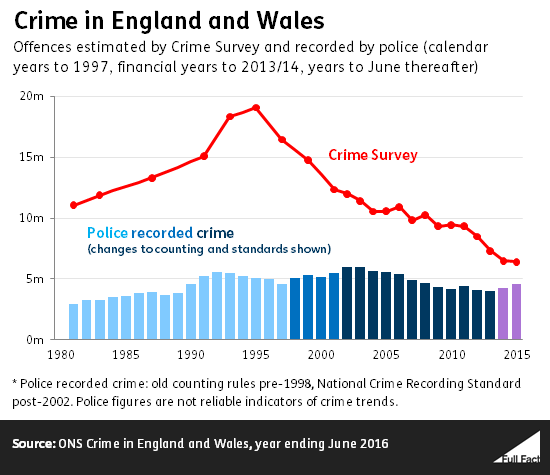Is crime about to double tomorrow?
When quarterly crime figures for England and Wales are released tomorrow they are going to appear to have shot up. They may even double. But this doesn’t mean that actual crime has doubled and it may not, in fact, have risen at all.
That’s because, for the first time, new estimates for fraud and cybercrime are going to be part of the measure in the Crime Survey. That’s one of the two key sources the Office of National Statistics uses to estimate crime rates.
We should say at this point that we haven’t seen tomorrow’s statistics. No-one has, except individuals on the ONS list for approved pre-release.
Crime data can only tell us so much about what’s happening in the real world. There’ll always be crimes that aren’t picked up by either the Crime Survey or the police.
Until recently, the compilers of the survey didn’t ask about fraud and cybercrime. Statisticians only began recording this data from September 2015. Tomorrow’s figures estimate crime in the 12 months ending in September 2016 - so the figures covering cybercrime and fraud will be included for the first time.
In a previous quarterly crime statistics bulletin, released in October, fraud and cybercrime were included as experimental statistics. When these experimental statistics are added to the survey’s main crime estimates, the number of crimes is doubled.
Does that mean every previous report we had on crime rates was wrong?
Well, that depends. We can only ever know as much as what we can measure. The Crime Survey has painted a consistent trend of certain kinds of crime since the 1980s. Those are the crimes that are experienced by victims and reported to the survey.
We simply don’t know exactly how widespread fraud and computer misuse offences were before now, so there's a limited amount anyone can say about trends in these kinds of crime.
But, just because the survey is expanding to cover new kinds of crime it doesn’t make the old estimates useless. They just need to be placed in context. They give us a useful idea of how many more conventional crimes like assault or burglary have happened over the years.
The new figures enhance that data by giving us information on fraud and computer crime as well and, soon enough, will produce new trends for politicians and everyone else to take account of.
Some background information:
- Crime as experienced and recounted by adults has been falling since the mid-1990s, according to the Crime Survey.

- The figures behind this trend don’t include fraud and cybercrimes - so no-one actually knows what trends would look like if they had been included.
All of these figures are distinct from police recorded crime, which only shows what crimes are being noticed by the police. Police figures are not reliable indicators of trends in crime over time, as shown here.
UPDATE: These figures have now been released and can be found here. Crime Statistics and Analysis Lead for the ONS John Flatley made this comment:
“In its 35 year history the Crime Survey has charted changing trends in crimes experienced by the population. In the past burglary and theft of vehicles were the high volume crimes driving trends but their numbers have fallen substantially since then. When the CSEW started, fraud was not considered a significant threat and the internet had yet to be invented. Today’s figures demonstrate how crime has changed, with fraud now the most commonly experienced offence. However, it should be emphasised that the new headline figures, including fraud and computer misuse, are not comparable with those from earlier years.”